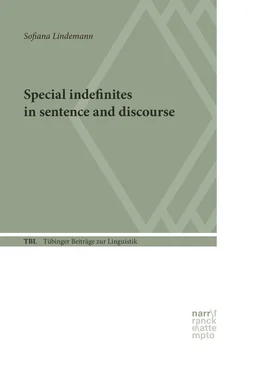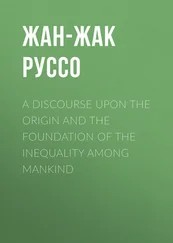| (3) |
(a) |
Paula wants to marry a Croatian. He is her neighbour. |
|
(b) |
Paula wants to marry a Croatian. She has to meet one first. |
Based on the findings from a cross-linguistic survey, Haspelmath (1997) points out that the distinction between specific and non-specific is so important that certain languages use different types of morphological or lexical markers to encode this distinction. As researchers focussed on one or more properties of indefinite noun phrases, different views on specificity emerged. This being so, it is no surprise that the concept of specificity has been used as a general term for several, partially overlapping phenomena such as: scopal specificity, epistemic specificity, partitive specificity and specificity as noteworthiness. In the literature on this topic we sometimes find the term referentiality being used as a synonymous expression for specificity (Fodor and Sag 1982, Givón 1984). However, in line with von Heusinger (2002), I consider that specificity and referentiality should be teased apart and be analysed as two distinct phenomena. In this book, referentiality is taken to be an indicator for the existence and accessibility in the discourse and specificity is understood in terms of the referential intention of the speaker or of another salient agent in the discourse. Contexts containing modals and non-factive propositional attitude verbs (i.e. operators, Heim 1981) make the distinction between a referential and a non-referential reading of an indefinite noun phrase clear. The indefinite in (3a), for example, scopes over the operator want and allows for an existential assertion of its associated referent. This allows for an interpretation in which the pronoun he in the second conjunct is bound by the indefinite noun phrase in the preceding sentence. The indefinite in (3a) has a referential reading and is specific as well, as it refers to an individual the speaker has in mind1. The indefinite in (3b), on the contrary, is interpreted inside the scope of the operator.
Over the past forty years, a wealth of research has focused on the analysis of referring expressions within larger discourse segments. It is generally accepted that discourses are structured in such a way as to achieve coherence. In order to successfully process a coherent discourse, discourse participants must construct a mental representation of the events being described. Definite and indefinite noun phrases represent one way to achieve such representations and to keep track of the referents introduced in the discourse. It has been argued that the position of an entity in a particular discourse structure determines the use of a particular type of referring expression in the subsequent mention of that referent. Prince (1988: 1) argues that when “a speaker evokes an entity in the discourse s/he first hypothesizes the information status of that entity in the hearer’s mind, with respect to both familiarity and saliency”. In the process of referring, speakers do not randomly opt for a particular type of referring expression; rather they choose the appropriate type of referring expression based on the referential status of the referent it is associated with. In other words, the use of a certain type of referring expression is negotiated at each point in the discourse between speakers and hearers. Thus, whether speakers use an indefinite noun phrase, a definite noun phrases, a pronoun, and so forth, to refer to a particular referent, depends on the information status of that entity at a particular time in the discourse. Prince (1988, 1992) captures the controversial notions of givenness and familiarity discussed above in a more intuitive classificational system of referential status, which impacts the choice of the type of referring expression. She introduces two fundamental referential statuses to account for the use of different types of referring expressions, namely the discourse status and the hearer status, as illustrated in Table 2.1. The discourse status reflects the discourse history of a referent and indicates whether a referent has already been evoked in the discourse (i.e. discourse-old), or not (i.e. discourse-new). The hearer status captures another dimension of the referent that pertains to the shared knowledge between discourse participants. According to this dimension, information is shared between the discourse participants if it was explicitly introduced in the discourse, or if it represents unused, old information for the hearer, otherwise the information is hearer-new.
|
Discourse-new |
Discourse-old |
| Hearer-new |
Brand-new |
- |
| Hearer-old |
Unused |
Textually evoked |
Table 2.1:
Taxonomy of referential status (Prince 1992)
The discourse status and the hearer status represent two dimensions of an entity and are not independent of each other. For example, if a referent is discourse-old (i.e. textually evoked), it must be hearer-old as well as it simultaneously represents shared information between the discourse participants. However, when a referent is discourse-new, it can represent both hearer-old (i.e. unused) and hearer-new (i.e. brand-new) entities. Prince (1992: 303) notes that the hearer-status is formally marked in English by definiteness, with hearer-new entities being typically realized as indefinite noun phrases and hearer-old entities being realized as definite noun phrases. The discourse status of a referent, however, remains more often than not unmarked.
Gundel, Hedberg and Zacharski (1993) propose an alternative discourse-pragmatic model to account for the proper use and felicitous processing of different types of referring expressions. The starting point of their analysis is the observation that the descriptive content of a certain type of referring expression restricts the set of possible referents to which the referring expression might apply to those referents that have (at least) the designated attention and memory status for the hearer. Each type of referring expression is linked to a precise memory node or cognitive status, which is in turn sufficient and necessary so that this referring expression can be used. Gundel et al. (1993) delimitate six cognitive statuses or mental representations, which are understood as processing instructions to the hearer as to which referent suits the referring expression best. The six cognitive statuses are arranged on a scale, ranging from “most restrictive” (i.e. the “in focus” status) to “least restrictive” (i.e. the “type identifiable” status). Table 2.2 illustrates the scale of cognitive statuses, called “the Givenness Hierarchy”, with English examples for each cognitive status.
| In focus> |
Activated> |
Familiar> |
Uniquely identifiable> |
Referential> |
Type identifiable |
| it |
that, this |
that N, this N |
the N |
indefinite this N |
a N |
Table 2.2:
The Givenness Hierarchy (Gundel, Hedberg and Zacharski 1993)
Because cognitive statuses are considered parts of mental representations, the Givenness Hierarchy does not give instructions about the way in which a certain type of referring expression acquires a certain status. For example, whether a referent is discourse-old or discourse-new in Prince’s (1992) terms, does not impact the cognitive status of the referent. Examples (4a) and (4b) illustrate the relation between a type of referring expression and the mental activation of the associated referent (Gundel et al. 1993).
| (4) |
(a) |
I couldn’t sleep last night. A dog (next door) kept me awake. |
|
(b) |
I couldn’t sleep last night. It kept me awake. |
According to this view, the hearer of sentence (4a) only has to know what the word dog means to understand the least restrictive simple indefinite noun phrase a dog . However, the hearer of sentence (4b) cannot understand the most restrictive form it unless s/he has a unique mental representation of the dog in question, which is also in his/ her focus of attention at the time the sentence is produced. The advantage of the Giveness Hierarchy lies in its implicational nature. A referential expression is individually and separately marked for the degree of accessibility its associated referent codes. The statuses are not mutually exclusive, they rather correlate with degrees of specification of some property and do not correspond to absolute degrees of the property. In other words, for any cognitive status on the Givenness Hierarchy, the associated referring expression codes the status indicated and simultaneously entails all lower statuses (i.e. the least restrictive ones, on its right). This prediction explains, for example, why a referent associated with the highest cognitive status “in focus” can be realized by referring expressions associated to all other lower statuses, i.e. “activated”, “familiar”, “uniquely identifiable”, “referential” and “type identifiable”. The indefinite determiner this in example (5), which codes the higher status “referential” can be replaced by the indefinite article a/an , which is associated to the lowest status “type identifiable”, given the unidirectional entailment relations of the Givenness Hierarchy.
Читать дальше












